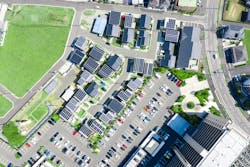Energy self-sufficiency in residential and mixed-use developments
In the US, we’ve had political debates for decades over energy independence and removing our dependence on foreign oil, but what about local communities, residential neighborhoods or business complexes seeking their own type of energy independence — from the utility grid? I would offer that this is also a worthy topic of conversation. Politics aside, there is a case for “energy independence” for all types of communities and developments. With the cultural and societal changes of the past three years alone, the need for reliable, ever-present power and connectivity has grown substantially.
For starters, the COVID-19 pandemic caused millions of people to work exclusively from home. As a result, the energy consumption that had been concentrated in office buildings has now spread out to increase work-related power needs in residential homes and developments. This is in addition to the already increasing power needs for our recreational devices.
The demand for electric vehicles (EV) is also on the rise. As more and more consumers convert to EVs, the power demand at the home will increase as will the demand on the grid for charging stations.
Lastly, what about natural disasters? Climate change is considered the driving factor for the increasing frequency of fires in California and Oregon, but there has been blame placed on utility companies as well. Rolling blackouts have become the new norm for California, and let’s not forget about the Texas 2021 storm’s cost.
I believe residential microgrids are a great solution to address all these modern day challenges. This energy self-sufficiency will reduce the load on the utility and allow communities to better control their energy utilization. The idea of a residential microgrid isn’t something new, as it’s a rapidly growing trend in Europe — not only for electricity, but also for heating and cooling using a gas genset combined heat and power (CHP) system. European countries are trending toward these developments because of environmental concerns as well as resiliency.
Mixed-use developments are quite standard in Europe as they offer socioeconomic benefits to the community — reducing commuting, allowing for businesses and communities to be tightknit. CHP is often used in these developments as a distributed energy system; for example, a 1-MW genset with heat exchanger connections per home.
There are several cases throughout the US where CHP has been used for mixed-use developments and a few for residential communities as well.
The burden of pushing for residential and mixed-use development microgrids lies on people in the industry to educate and promote our technologies to developers as well as the public. Keep in mind, only in deregulated states is there an opportunity for these microgrids. Both Texas and California, states with the greatest populations and some of the most problematic outages, are deregulated and offer tremendous opportunities.
However, to be successful, the marketability of residential and mixed-use microgrids needs to be pursued in the early development stages of new communities before the developer even submits plans to the city. From speaking with several developers, my take on the situation is that there is interest in having energy independence from the utility, provided that the concept would be beneficial to the community, neighborhood and developer.
With residential microgrids, the potential for less expensive power is available, especially if there are more homes, residents or businesses that are part of the community. These microgrids can provide guaranteed power and, in some scenarios, peak shaving could also be part of the economic draw. There is also an opportunity for the developer or residents to own their own power. Wouldn’t that be interesting?
There are several contractual mechanisms that could be used for these developments to become energy self-sufficient, have comfort in knowing they’ll have continuous power and potentially less power cost by using a residential microgrid. I think this is a market for us in the industry to pursue. Not only could it be profitable, but it could also improve the lives of others.
Jonathan Abaee is senior sales manager, gas power solutions, North America for the Power Systems division of Rolls-Royce.








